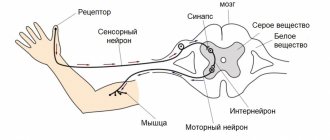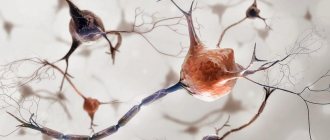What is psychosis
Psychosis is a mental disorder in which reactions contradict the real situation.
It becomes difficult for a person to separate his own feelings from reality, which causes distortions in the perception of reality and behavior becomes inappropriate. He can see or hear something that is not there. With this disease, hallucinations are also observed, most often auditory. Often there is a violation of the logical-semantic structure of thinking. Delusional ideas appear, fears arise about persecution, the presence of a controlling alien will, the struggle of higher powers, and so on. The author of the term “psychosis” is considered to be the German doctor Karl Friedrich Cannstatt. He used this word in one of his works to denote the “psychological manifestation of brain disease”
.
According to another version, the author of the term is the surgeon, psychiatrist, philosopher Ernst Maria von Feuchtersleben. He replaced the concept of “psychosis” with “madness”
and
. ”
Based on their origin, psychoses are divided into endogenous
, associated with internal causes (somatic diseases, hereditary mental disorders), and
exoorganic
, caused by external factors or a violation of the structure of the brain (trauma, hemorrhage, etc.).
Difference between depressive neurosis and other neurotic disorders
First, let's find out what the differences between depression and neurosis are. Neurosis is a general concept for a whole group of psychogenic disorders, the appearance of which is caused by regular exposure to external stress factors. In the early stages of the disease, it is enough to eliminate these factors or change your attitude towards them for recovery to occur.
Depression is an affective disorder, that is, a mood disorder, which is characterized by a lack of ability to enjoy the positive phenomena of life, an unreasonable depressed state for a long time, a significant loss of strength and extreme fatigue. With depression, external factors are basically just a catalyst that triggers a serious illness formed by endogenous causes, including hereditary ones. The combination of a depressive and neurotic clinical picture is characteristic of depressive neurosis, but in a significantly softened version.
Despite apathy and a decrease in mental activity, the patient remains able to work, and in some circumstances is even absorbed in work; general lethargy has virtually no effect on the results of work. Apathy extends more to relationships in society - there is no desire to communicate or attend crowded meetings. The skills of habitual socialization themselves do not disappear, interest in them simply dries up.
There is no total depression; patients diagnosed with depressive neurosis do not lose self-control and are capable of adequate communication and assessment of what is happening. They do not have the painful feeling of a lack of feelings and a complete disappearance of emotions and interest in life. The sleep disturbances characteristic of ordinary depression in the form of early awakenings with the inability to resume sleep again are absent or only rarely appear. During the day, the condition may worsen slightly in the evening, while with a purely affective depressive disorder, on the contrary, it becomes a little easier in the evening. The presence of somato-vegetative disorders in this disease forces one to turn to general practitioners (most often therapists, neurologists) who treat common diseases, who can prescribe symptomatic treatment that does not correct the situation and prolongs the course of the disease.
As a differentiation from similar disorders, morning fatigue, characteristic of asthenic neurosis, is not accompanied by feelings of melancholy, restlessness and anxiety, as with depression, just as there is no extreme fixation on symptoms and the search for imaginary diseases, as is the case with hypochondria.
In general, the symptoms are much milder than the clinical picture of classical depression, in which the future is hopeless. Neurotic depression allows you to plan, see prospects and strive to achieve them, while bracketing the negativity of the existing unfavorable state of affairs. All these features and subtle differences can only be noticed by an experienced psychotherapist in order to differentiate depressive neurosis from other types of neurotic and affective disorders.
What is neurosis
Neurosis is a long-term chronic disorder that can develop in a person against the background of stress or a traumatic event. This condition is characterized by hysterical manifestations and a temporary decrease in performance. As a rule, neuroses arise as a result of circumstances that caused psychological trauma, stress, emotional overstrain, and conflicts.
The concept of “neurosis” was introduced into medicine in 1776 by Scottish physician William Cullen. The content of the term has been revised several times; there is still no unambiguous generally accepted definition of the term. It should also be borne in mind that in medicine and biology, “neurosis” can be called various functional disorders of higher nervous activity.
The most common types of neurosis are neurasthenia (for example, fatigue syndrome), hysteria (hysterical neurosis), phobias (fears, panic attacks), obsessive states (obsessive neurosis).
Symptoms of neurosis include depressed mood, irritability, frequent mood swings, obsessive thoughts, poor appetite, increased sensitivity to noise, light, vibrations and more.
Symptoms of psychoses and neuroses
In psychosis, the characteristic symptoms are visual and auditory hallucinations. A person often has delusional, obsessive ideas. There may be a lack of understanding of reality. The patient is not capable of adequate perception of the surrounding world. Mood changes frequently, uncontrolled aggression is possible, which can turn into physical violence. People with this pathology are easily irritated; Even a minor reason can cause anger; sometimes anger arises for no reason. Speech is abrupt and chaotic. Characteristic is a gradual development of symptoms.
Neuroses have other manifestations. The nervous system is exhausted, there is a constant feeling of fatigue, apathy, and reluctance to do anything. A person gets tired quickly, suffers from headaches, and has difficulty falling asleep. Hysteria is possible: emotional reactions become excessively violent, chaotic movements and speech disturbances are observed during a seizure. Perhaps restlessness, constant causeless anxiety. Patients are suspicious, prone to obsessive actions and thoughts.
Often only some of the symptoms appear.
Differences between psychosis and neurosis
With neurosis, the patient’s personality, as a rule, does not undergo major changes. A person is still able to think critically about the disease and his own actions (which is one of the signs of a normal mental state), and is also able to control his behavior. While psychosis can change the patient's personality. Actions are difficult to control and are not realized by a person.
Another difference is that patients with psychosis experience mental disorders, while patients with neurosis also experience physical deterioration.
Neurosis in most cases is a reversible condition. It is much more difficult to cure psychosis, in particular due to the fact that the patient with such a disease does not consider himself sick.
If you observe any physical or mental disorders, you should consult a specialist and not engage in self-diagnosis and self-medication. This may make the condition worse.
Characteristics of neurosis
Neurosis is not a disease, but a painful condition that combines a whole group of psychogenic disorders and is traditionally considered as a functional disorder of the higher nervous activity of the upper nervous system.
Neurosis does not have an unambiguous definition either in biology or in medicine, but to one degree or another it is familiar to every person. In Russia alone, according to WHO, up to 75% of the population suffers from neurotic disorders, and every year the frightening figure is steadily growing.
Neuroses are dangerous. They can cause a lot of inconvenience, including complete loss of ability to work. But if you consult a specialist in a timely manner and follow the recommendations, they are completely curable. Neurologists and psychotherapists treat disorders of this kind.
The forms of neurosis are quite diverse. Conventionally, they can be divided into two large groups. The first group includes conditions associated with stress: various phobias in which anxiety is provoked by external situations and objects that are not currently dangerous. The second group includes conditions associated with physiological (physical) disorders: anorexia nervosa, bulimia, etc.
Agoraphobia
A term that combines a number of interdependent fears.
For example, fear of leaving the apartment and entering the store. Fear of traveling and being in crowds. The clinical picture of agoraphobia is very diverse. In most cases, symptoms such as dizziness, migraine, lightheadedness or rapid heartbeat are observed. The intensity of anxiety can vary from mild discomfort to panic terror.
Women get sick more often than men. The onset of the disease occurs mainly in adulthood. The main danger is that the patient can completely isolate himself from society, closing himself “within four walls.”
Social phobias
Neuroses that combine fears associated with being in society. Isolated (eg, drinking or eating in public) or diffuse (including most situations outside the family circle). They are often combined with a panicky fear of criticism and low levels of self-esteem. Often accompanied by hand tremors, redness of the skin, the urge to urinate, sudden nausea and vomiting.
Specific phobias
A term that combines fears that are limited to strictly defined circumstances (the sight of blood, being near an object, a thunderstorm, flying on an airplane, being treated by a doctor, etc.). They usually appear in childhood or adolescence and, without proper treatment, persist throughout life. The severity of discomfort resulting from specific phobias depends on how easily the traumatic situation can be avoided.
Paroxysmal anxiety
A group of phobias that are not limited to specific situations. Fears arise suddenly. They have an unpredictable, paroxysmal character.
Typically lasts a few minutes.
Accompanied by chest pain, rapid heartbeat, shortness of breath, a feeling of derealization and depersonalization (loss of the sense of reality of what is happening).
Obsessive-compulsive disorders
Neurosis characterized by repeated actions or thoughts over and over again. Attractions, images or ideas that are almost always aggressive or distressing.
The disorder is typical for both men and women. Appears, as a rule, in adolescence and eventually develops into a chronic form. Often accompanied by depression.
Anorexia nervosa
A disorder characterized by intentional weight loss caused directly by the affected person. It often occurs in teenage girls and young women. The clinical picture is easily recognized: body weight is at least 15% less than expected. The most valuable obsession is the horror of obesity.
Bulimia nervosa
A disorder in which strong food cravings are combined with a morbid fear of obesity. A sick person rushes “from one extreme to another”, tends to abuse laxatives or induce vomiting.
There are other physiological disorders: sexual dysfunctions, sleep disorders, etc. However, in practice, they are usually dealt with by specialists of a narrow profile.










